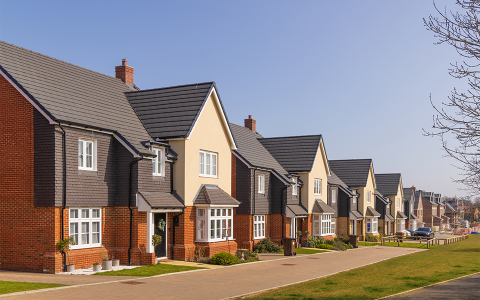Heat pumps
Renewable energy solutions for sustainable buildings using natural sources such as air, ground and water to provide heating, cooling and hot water.
Heat pumps are the perfect partner for heating and cooling systems designed to work at lower temperatures, helping to support the design and construction of more energy-efficient and cost-effective buildings.
Read our technical guideTypes of Heat Pumps
For new residential dwellings, Air Source Monobloc and Split System technologies are ideal solutions for high efficiency hot water generation and space heating.
Air Source Heat Pumps (ASHPs)Hot Water Heat Pumps are a low-carbon technology water heater, designed to be an alternative to gas boilers installed within a building.
Hot Water Heat PumpsAmbient Loop heating systems use a network of water heat pumps connected to an ambient loop and can improve the energy performance and running costs of a building.
Ambient Loop NetworkWhat do heat pumps mean for you?
All in one soluton
Heat pumps can be used to both heat a home or building as well as provide hot water.
Environmentally friendly solution
No carbon dioxide output helping to reduce carbon footprint of homes and commercial buildings.
Saving money on energy bills
By using natural sources to generate heat, this renewable heating system doesn't rely on the national grid for energy.
High output low noise
These heating systems use technology that helps reduce noise while they operate, making them a clean and quiet way to heat a building.
How do heat pumps work?
These systems extract heat from natural sources such as air and water and transfer it to a refrigerant, which is a fluid with a very low evaporation temperature. Once the refrigerant is heated it is turned into a gas, which is then compressed to further increase its temperature. The compressed gas is then used to heat water for domestic and commercial use. Finally, an expansion valve reverts the gas back into a liquid and the cycle starts again.
Featured product
Edel
Our Edel RF Hot Water Heat Pump (HWHP) is a low carbon technology for heating hot water. This heat pump can create hot water up to 60°C, is high performance with low operational noise and is suitable for installation within service cupboards, garages and utility rooms.
Product Specification
Our Heat Design Team
Specifying a heat pump is important to maximising a building’s energy efficiency. Dimplex’s heat design team can ensure that your solution selection and system design are accurately matched to the unique requirements of your project.
Sign up now to access our comprehensive guides and detailed knowledge articles
Visit our Knowledge CentreGround and Water Source Heat Pumps
Ground and Water Source heat pumps are ideal for projects where early consideration can be given to groundworks and infrastructure. These variations are best suited to developments that are located near a large body of water or where a large trench can be dug before building begins.
FAQ
Air Source Heat Pumps (ASHPs)
Air source heat pumps (ASHPs) are often easier to install than their ground or water source alternative as they only require connection to the main water supply, an electrical connection and in some instances a refrigerant connection. This type of heat pump is ideal where space is limited as there is generally no need to bury pipes or be close to other energy sources such as boreholes, canals or large bodies of water. Air source heat pumps can be used in residential and commercial applications of all sizes including high rise buildings where the units can be installed on the roof or at ground level.
Ambient Loops
Beyond using water as the primary energy source from which heat is drawn, heat pumps can also be used in a closed water to water ambient loop, kept within operating parameters by a primary plant technology such as an air source heat pump or a gas boiler. Reverse cycle heat pumps can transfer rejected energy from one area to another within a space or a building where there is a requirement. Where there is not a demand for this energy, it is rejected from this internal loop into the external surroundings or stored within buffer vessels to be drawn upon when needed. These are growing in popularity within communal residential schemes, especially in city developments which can benefit from a low temperature network.
Hot Water Heat Pumps
Hot water heat pumps (HWHPs) are a low carbon technology for heating hot water and are designed to be installed within the dwelling itself. They consist of a ducted system to supply external air to an air source heat pump mounted on top of a water cylinder. The heat pump collects energy from the ambient air and converts this into heat, which is then transferred to the water within the cylinder, creating hot water to be used in the building. The remaining cold air is then discharged outside.
Hot water heat pumps are often used as part of a hybrid heat pump system; predominantly used in new build residential applications to provide hot water, alongside a separate electric or gas heating system. This makes HWHPs a highly flexible system with cost and installation benefits when compared to their larger heating and hot water alternative.
Ground source heat pumps (GSHPs)
Ground source heat pumps (GSHPs) use a series of ground loops to absorb heat energy from the ground. These loops can either be installed in horizontal trenches around one meter in depth, or vertically in a borehole. Boreholes offer a little less disruption to the surrounding landscape but may require a little more capital upfront for the installation. GSHPs can be better suited for new build developments where the need for external space, (to install the ground loop) and the internal space (for the buffer tank and water cylinder) can be factored in at the early design stages. They can also be installed in existing buildings where the space and geographical needs are met and disruption is not an issue.
Heat pumps and hot water heat pumps provide an efficient way to meet the hot water and space heating demands within a building. Compared to boilers with a typical Coefficient of Performance (COP) of 0.9, heat pumps can achieve a COP of over 2.0 for hot water and over 3.0 for space heating. The higher efficiency of heat pumps increases their cost-effectiveness. Achieving this target can be challenging. However, the specification of heat pumps will meet that challenge and can also help maximise efficiency and minimise running costs.
Heat pumps are reducing in cost as the market grows. The initial outlay can be offset by the government's Boiler Upgrade Scheme, launched in April 2022. This gives homeowners a grant of £5,000 towards the installation of an air source heat pump and £6,000 towards the cost of a ground source heat pump installed by an MCS (Microgeneration Certification Scheme) accredited installer. This scheme is expected to run for three years, leading to 2025. As with all government schemes, it is worth checking that it is still available and keeping an eye out for new schemes as the push to net zero carbon gathers pace.
The sound level air source heat pumps (ASHPs) produce will depend on the type, monobloc or split system, make and model of the unit. This must be no greater than 42 dB(A) (the noise level you would experience in a quiet library) under the Microgeneration Certification Scheme Planning Standards (MCS) before they can be allowed as permitted development. Some exterior ASHPs can have special noise reducing casings if they are installed in enclosed spaces where noise might be more noticeable, such as courtyards. Ducted ASHPs can be installed inside the dwelling as another way of achieving the required level of acoustic comfort.
Heat pumps can be installed in existing homes that undergo a deep retrofit. Where the fabric energy efficiency is high, low carbon heating technologies are a viable alternative to gas and can deliver hot water and space heating effectively.
Heat pump installers, like gas boiler installers, are trained to fit the equipment correctly in line with the manufacturer's guidelines, applicable industry standards, and regulations. So, heat pumps do not require specialist installers. Manufacturers of innovative low carbon technologies, such as ambient heat networks and hot water heat pumps, often design their systems to be pre-plumbed and pre-wired to optimise the speed and quality of installation.
Useful information
What are the different types of heat pumps and where would you use them?
The three types of these solutions are classified by where they source their primary energy: air, ground or water. Each has its benefits depending on the application and specific design conditions.
find out moreThe six main heat pump myths debunked
The increased focus on heat pumps, both monobloc and split system heaters, has intensified the discussion on this low carbon technology that is sometimes misunderstood.
find out moreSpecification drivers of air source heat pumps for residential dwellings
The main specification driver of monobloc air source and split system heat pumps for residential dwellings is focused on selecting a heat pump with the right performance output to match the heating and hot water demands of the dwelling.
find out moreHybrid heat pump electric panel heating new developments
Highly efficient hybrid electric solutions combine hot water systems and direct electric panel heating to reduce the carbon footprint of new build residential developments.
find out moreOur range of CPD UK and CIBSE accredited CPDs provide building professionals with the knowledge and confidence to specify, design, and implement heat pumps. All CPDs can be delivered online or in person.
CPDsOur specifier hub provides expert support and design insights, helping you save time specifying our solutions that meet your project’s sustainability goals while adhering to the latest building regulations.
Specifier HubWe can offer hands-on face-to-face training on Dimplex products, including heat pump principles and servicing, and a course covering our Edel hot water heat pump.
Product training
New heating regulations: What does it mean for you?
Homeowners looking to update and replace their heating systems this spring need to be aware of the new EU EcoDesign legislation, also known as Lot 20 within the industry, which came into force on January 1st this year.

No need to bring gas into the electric heating debate
Upgrading incorrectly specified appliances is the key to reducing fuel poverty in electrically heated homes, not connecting properties to the gas grid.

Part 1 - London Environment Strategy: What does it mean?
The draft London Environment Strategy, published by the Greater London Authority in August, sets out the authority’s plan to tackle environmental and energy challenges in the capital. It makes clear that if the target of making London zero carbon by 2050 is to be achieved, big changes need to be made to the way in which heating and cooling systems are designed.











